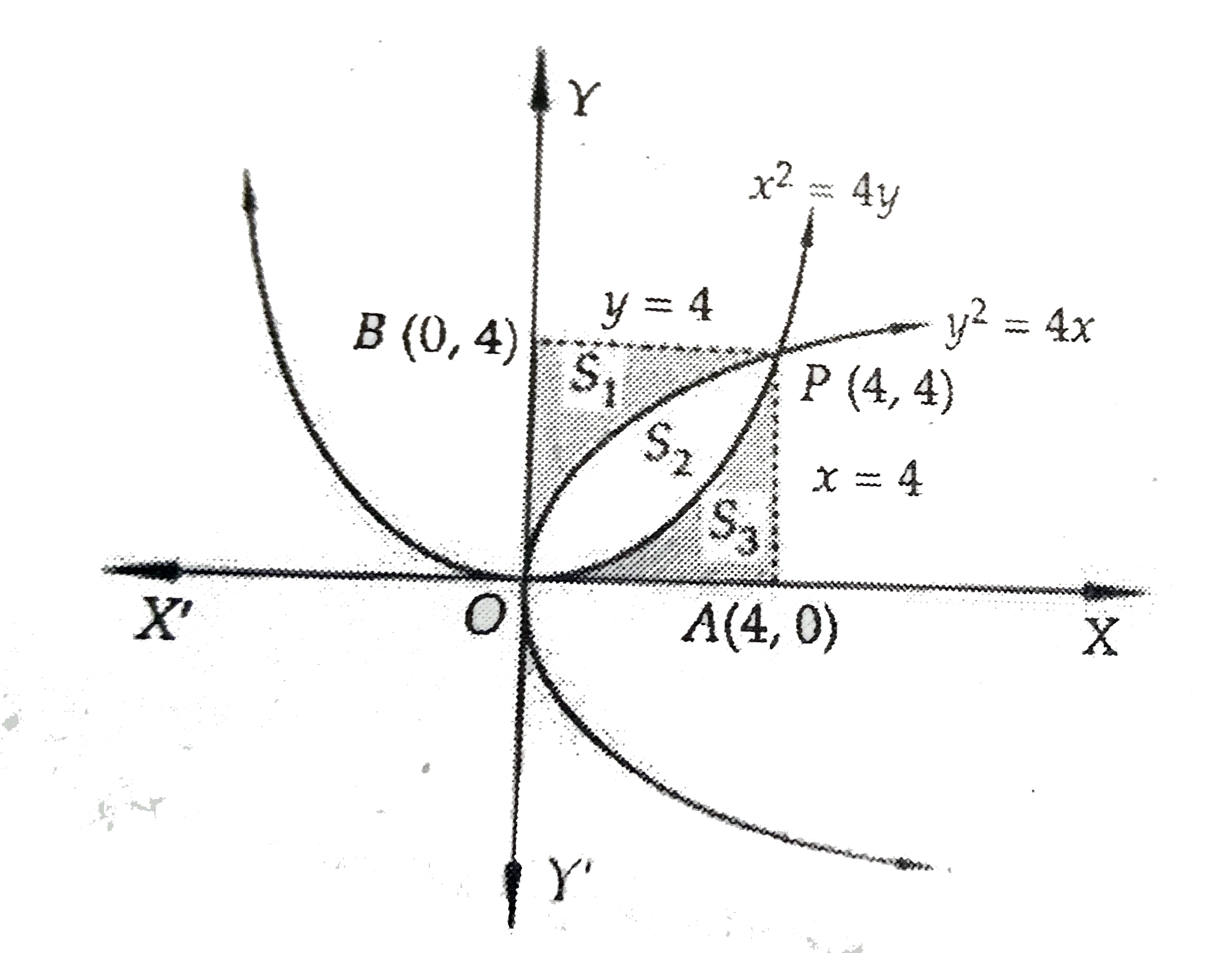The parabolas y2=4xandx2=4y divide the square region bounded by the lines x=4,y=4 and the coordinate axes. If S1,S2,S3 are the areas of these parts numbered from top to bottom, respectively, then S1:S2≡1:1 (b) S2:S3≡1:2 S1:S3≡1:1 (d) S1:(S1+S2)=1:2
1:1:1
2:1:2
1:2:3
1:3:2
The correct Answer is:a
Clearly, y2=4xandx2=4y intersect at (4,4).
∴S2+S3=4∫0√4xdx
⇒S2+S3=24∫0√xdx=43[x3/2]40=323 sq. units
and S3=4∫0x24dy=14[x33]40=163 sq. units

Thus, we have
S2+S3=323andS3=163⇒S2=163 sq. units.
∵S1+S2+S3=Area of squareOAPB=4×4=16 sq. units.
∴S2=163sq. units. [∵S2=S3=163sq. units]
Hence, S1:S2:S3=1:1:1
Topper's Solved these Questions
- BOOK - OBJECTIVE RD SHARMACHAPTER - AREAS OF BOUNDED REGIONSEXERCISE - Exercise62videos
AREAS OF BOUNDED REGIONS
- BOOK - OBJECTIVE RD SHARMACHAPTER - AREAS OF BOUNDED REGIONSEXERCISE - Chapter Test60videos
AREAS OF BOUNDED REGIONS
- BOOK - OBJECTIVE RD SHARMACHAPTER - APPLICATION OF DERIVATIVESEXERCISE - Illustration6videos
APPLICATION OF DERIVATIVES
- BOOK - OBJECTIVE RD SHARMACHAPTER - CARTESIAN PRODUCT OF SETS AND RELATIONS EXERCISE - Chapter Test31videos
CARTESIAN PRODUCT OF SETS AND RELATIONS
Similar Questions
The parabolas y2=4xandx2=4y divide the square region bounded by the lines x=4,y=4 and the coordinate axes. If S1,S2,S3 are the areas of these parts numbered from top to bottom, respectively, then S1:S2≡1:1 (b) S2:S3≡1:2 S1:S3≡1:1 (d) S1:(S1+S2)=1:2
View SolutionThe parabola x2=4y and y2=4x divide the square region bounded by the lines x=4, y=4 and the coordinate axes. If S1,S2,S3 are respectively the areas of these parts numbered from top to bottom, then S1:S2:S3 is (A) 2:1:2 (B) 1:2:1 (C) 1:2:3 (D) 1:1:1
View Solution
Knowledge Check
- Question 1 - Select One or More
The parabolas y2=4xandx2=4y divide the square region bounded by the lines x=4, y=4 and the coordinate axes. If S1,S2,S3 are the areas of these parts numbered from top to bottom, respectively, then
AS1:S2≡1:1BS2:S3≡1:2CS1:S3≡1:1DS1:(S1+S2)=1:2 - Question 2 - Select One
The parabola y2=4x and x2=4y divide the square region bounded by the lines x=4, y=4 and the coordinate axes. If S1,S2,S3 are respectively the areas of these parts numbered from top to bottom, then S1:S2:S3 is equal to
A1:1:1B2:1:2C1:2:3D1:2:1 - Question 3 - Select One
The parabolas y2=4xandx2=4y divide the square region bounded by the lines x=4, y=4 and the coordinate axes. If S1,S2,S3 are the areas of these parts numbered from top to bottom, respectively, then
A2:1:2B1:1:1C1:2:1D1:2:3
If S1,S2,S3 are the sums of first n natural numbers, their squares and their cubes respectively then S3(1+8S1)=
View SolutionIf S1,S2,S3 are the sums of first n natural numbers, their squares and cubes respectively, show that 9S22=S3(1+8S1).
View SolutionIf S1,S2,S3are the sum of first n natural numbers, their squares and their cubes, respectively, show that 9S22=S3(1+8S1).
View SolutionIf S1,S2,S3 are the sums to n, 2n, 3n terms respectively for a GP then prove that S1,S2−S1,S3−S2 are in GP.
View SolutionIf S1,S2andS3 are the sums of first n natureal numbers, their squares and their cubes respectively, then S41S22−S22S23S21+S22=
View Solution

